
Algae is an informal term for a large and diverse group of photosynthetic eukaryotic organisms. It is a polyphyletic grouping that includes species from multiple distinct clades. Included organisms range from unicellular microalgae, such as Chlorella,Prototheca and the diatoms, to multicellular forms, such as the giant kelp, a large brown alga which may grow up to 50 metres (160 ft) in length. Most are aquatic and autotrophic and lack many of the distinct cell and tissue types, such as stomata, xylem and phloem, which are found in land plants. The largest and most complex marine algae are called seaweeds, while the most complex freshwater forms are the Charophyta, a division of green algae which includes, for example, Spirogyra and stoneworts.

A lichen is a composite organism that arises from algae or cyanobacteria living among filaments of multiple fungi species in a mutualistic relationship. Lichens have properties different from those of their component organisms. They come in many colors, sizes, and forms and are sometimes plant-like, but lichens are not plants. They may have tiny, leafless branches (fruticose); flat leaf-like structures (foliose); crust-like, adhering tightly to a surface (substrate) like a thick coat of paint (crustose); a powder-like appearance (leprose); or other growth forms.
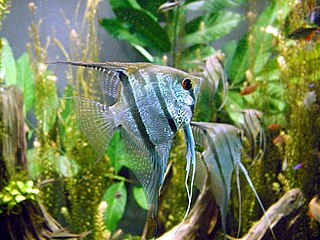
Pterophyllum is a small genus of freshwater fish from the family Cichlidae known to most aquarists as angelfish. All Pterophyllum species originate from the Amazon Basin, Orinoco Basin and various rivers in the Guiana Shield in tropical South America. The three species of Pterophyllum are unusually shaped for cichlids being greatly laterally compressed, with round bodies and elongated triangular dorsal and anal fins. This body shape allows them to hide among roots and plants, often on a vertical surface. Naturally occurring angelfish are frequently striped transversely, colouration which provides additional camouflage. Angelfish are ambush predators and prey on small fish and macroinvertebrates. All Pterophyllum species form monogamous pairs. Eggs are generally laid on a submerged log or a flattened leaf. As is the case for other cichlids, brood care is highly developed.
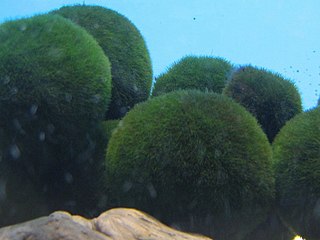
Marimo is a rare growth form of Aegagropila linnaei in which the algae grow into large green balls with a velvety appearance.

A marine aquarium is an aquarium that keeps marine plants and animals in a contained environment. Marine aquaria are further subdivided by hobbyists into fish only (FO), fish only with live rock (FOWLR), and reef aquaria. Fish only tanks often showcase large or aggressive marine fish species and generally rely on mechanical and chemical filtration. FOWLR and reef tanks use live rock, a material composed of coral skeletons harboring beneficial nitrogen waste metabolizing bacteria, as a means of more natural biological filtration.
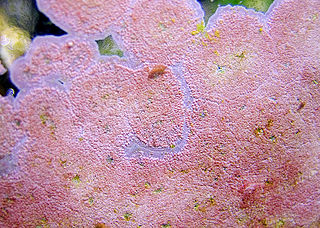
Coralline algae are red algae in the order Corallinales. They are characterized by a thallus that is hard because of calcareous deposits contained within the cell walls. The colors of these algae are most typically pink, or some other shade of red, but some species can be purple, yellow, blue, white, or gray-green. Coralline algae play an important role in the ecology of coral reefs. Sea urchins, parrot fish, and limpets and chitons feed on coralline algae. In the temperate Mediterranean Sea, coralline algae are the main builders of a typical algal reef, the Coralligène ("coralligenous"). Many are typically encrusting and rock-like, found in marine waters all over the world. Only one species lives in freshwater. Unattached specimens may form relatively smooth compact balls to warty or fruticose thalli.
Community aquaria are tanks that are designed to contain more than one species of fish. Most commonly they include a variety of species that do not normally occur together in nature, for example angelfish from Brazil, swordtails from Mexico, and gouramis from South East Asia. The aim of such communities is to bring together fish that are compatible in temperament and water requirements, while using their different colours and behaviors to add interest and entertainment value.
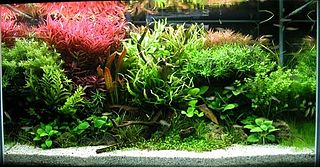
Aquascaping is the craft of arranging aquatic plants, as well as rocks, stones, cavework, or driftwood, in an aesthetically pleasing manner within an aquarium—in effect, gardening under water. Aquascape designs include a number of distinct styles, including the garden-like Dutch style and the Japanese-inspired nature style. Typically, an aquascape houses fish as well as plants, although it is possible to create an aquascape with plants only, or with rockwork or other hardscape and no plants.

Fishkeeping is a popular hobby, practiced by aquarists, concerned with keeping fish in a home aquarium or garden pond. There is also a piscicultural fishkeeping industry, as a branch of agriculture.

The Siamese algae-eater is a species of freshwater fish in the carp family, Cyprinidae. This bottom-dwelling tropical fish is found in mainland Southeast Asia, including the Chao Phraya and Mekong basins as well as the Malay Peninsula. Its natural habitats are streams and rivers as well as flooded forests during the rainy season. The Siamese algae-eater should not be confused with the flying fox or the false siamensis , lacking the distinctive black bands of the former.
Algae eater, also called an algivore, is a common name for many bottom-dwelling or algae-eating species that feed on algae. Algae eaters are important for the fishkeeping hobby and many are commonly kept by hobbyists.

Polysiphonia is a genus of filamentous red algae with about 19 species on the coasts of the British Isles and about 200 species worldwide, including Crete in Greece, Antarctica and Greenland. Its members are known by a number of common names. It is in the order Ceramiales and family Rhodomelaceae.

Vittina natalensis, common name spotted nerite, is a species of small freshwater snail with an operculum, an aquatic gastropod mollusk in the family Neritidae, the nerites.
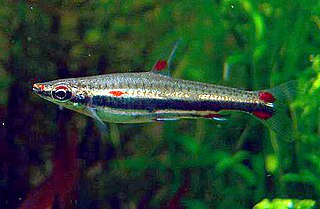
Nannostomus trifasciatus,, commonly known as the three-lined or three-stripe pencilfish, is a freshwater species of fish belonging to the characin family Lebiasinidae. They are popular in the aquarium trade due to their small size, beautiful color pattern, and relative hardiness.
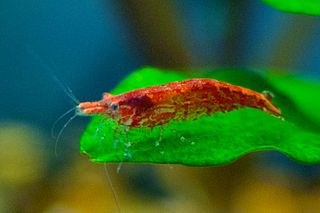
Neocaridina davidi is a freshwater shrimp from Taiwan which is commonly kept in aquaria. The natural coloration of the shrimp is green-brown. There are a wide range of colors such as red, yellow, orange, green, blue, violet, black, etc., however, the red morph is more frequently sold. The density of coloration on adult shrimp, dependent on breeding, determines their sale price and "quality" (grading). This "quality" is purely aesthetic, as the size, behavior and other characteristics of the animal is more or less equal across varieties. Full-grown shrimp reach about 4 centimetres (1.6 in) long. They prefer clean water, with a pH of 6.5-8, and a temperature of 14–29 °C (57–84 °F) They are most comfortable at 22 °C (72 °F). N. davidi shrimp are omnivores that may live 1–2 years. These shrimp have previously been classified as Neocaridina heteropoda and Neocaridina denticulata sinensis, however are now known as Neocaridina davidi which is based on the oldest known published description of the species.

An aquarium is a vivarium of any size having at least one transparent side in which aquatic plants or animals are kept and displayed. Fishkeepers use aquaria to keep fish, invertebrates, amphibians, aquatic reptiles, such as turtles, and aquatic plants. The term aquarium, coined by English naturalist Philip Henry Gosse, combines the Latin root aqua, meaning 'water', with the suffix -arium, meaning 'a place for relating to'.
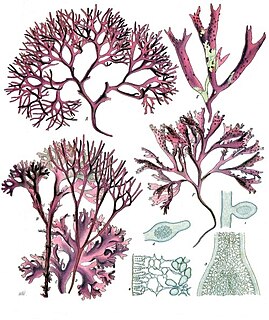
Red algae, or Rhodophyta, are one of the oldest groups of eukaryotic algae. The Rhodophyta also comprises one of the largest phyla of algae, containing over 7,000 currently recognized species with taxonomic revisions ongoing. The majority of species (6,793) are found in the Florideophyceae (class), and mostly consist of multicellular, marine algae, including many notable seaweeds. Red algae are abundant in marine habitats but are relatively rare in freshwaters. Approximately 5% of the red algae occur in freshwater environments with greater concentrations found in warmer areas. Except for two coastal cave dwelling species in the asexual class Cyanidiophyceae, there are no terrestrial species, which may be due to an evolutionary bottleneck where the last common ancestor lost about 25% of its core genes and much of its evolutionary plasticity.
Bangia is an extant genus of division Rhodophyta that grows in marine or freshwater habitats. Bangia has small thalli with rapid growth and high reproductive output, and exhibits behavior characteristic of r-selected species. The plants are attached by down-growing rhizoids, usually in dense purple-black to rust-colored clumps. The chloroplasts of Bangia, like others in the division Rhodophyta, contain chlorophyll a and sometimes chlorophyll d, as well as accessory pigments such as phycobilin pigments and xanthophylls. Depending on the relative proportions of these pigments and the light conditions, the overall color of the plant can range from green to red to purple to grey; however, the red pigment, phycoerythrin, is usually dominant.
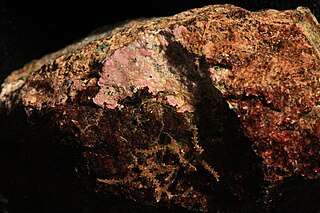
Hildenbrandia is a genus of thalloid red alga comprising 26 species. The slow-growing, non-mineralized thalli take a crustose form. Hildenbrandia reproduces by means of conceptacles and produces tetraspores.

Crossocheilus langei, also known as the red algae eater, is a species of ray-finned fish in the genus Crossocheilus. It is native to Malaysia and Sumatra. This bottom-dwelling tropical fish is found in mainland Southeast Asia. Its natural habitats are streams and rivers as well as flooded forests during the rainy season. It is often confused with the Crossocheilus oblongus, however, both are algae eaters and will behave similarly.

















